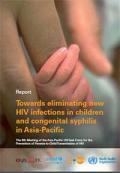Publications - Released in 2011
The HIV epidemic in Asia-Pacific is growing rapidly, although most countries have low HIV prevalence while some have concentrated epidemics. AIDS is increasingly feminized through intimate partners’ transmission with gradual increase of new HIV infections among low-risk women and consequent mother-to-child transmission. In 2008, an estimated 1.4 million women and 161,000 children aged 14 years and under were infected with HIV in the region. The estimated number of HIV-positive pregnant women was 85,000. New infections in children totalled 19,700, while 11,700 children died of causes related to AIDS.
Several regional initiatives have been made to address these issues, including a recent focus on eliminating new HIV infections in children and congenital syphilis. On 25 November 2010, UNICEF, WHO, UNAIDS and UNFPA, with support from over 150 delegates from 20 countries across Asia-Pacific, adopted the historic goal of eliminating all new paediatric HIV and CS infections in the region by 2015. The declaration of elimination as an aim by the Asia-Pacific UN PPTCT Task Force represents a paradigm shift in the response to HIV & AIDS and CS. Previously, agencies and health care providers had been working to prevent as many new infections as possible, with growing success but still with enormous gaps to be filled.
Downloads
Organizations
- United Nations Children’s Fund (UNICEF)






